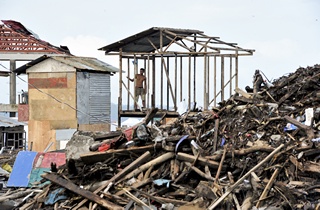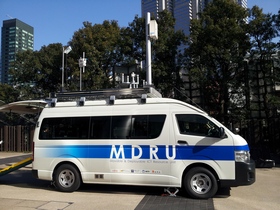Two days before Typhoon Haiyan (locally known as Yolanda) made landfall in central Philippines on 8 November 2013, Engineer Romarico Cabellon, a municipal planning and development coordinator in San Remigio was busy ensuring the timely delivery of essential relief supplies to areas that had been designated as evacuation centers by the local authorities. "We distributed food supplies, prepared stock of medicines, provided relief workers with telephone lines, mobile phones and ensured there was internet connection. We made every effort to ensure the evacuation centers would stay in touch with the main disaster coordination center in the city."
 But nothing was to prepare Engineer Cabellon for what was to come next. As the storm barreled across San Remigio city, many of the evacuation centers he had helped to prepare could not withstand the force of the storm. Roofs were blown off, walls collapsed, trees were uprooted and strewn hundreds of meters from where they once stood.
But nothing was to prepare Engineer Cabellon for what was to come next. As the storm barreled across San Remigio city, many of the evacuation centers he had helped to prepare could not withstand the force of the storm. Roofs were blown off, walls collapsed, trees were uprooted and strewn hundreds of meters from where they once stood.
"In the midst of the storm, power supply went out and within minutes our communication lines both landline and mobiles were went down too. We were not just on darkness but we were out of reach'' says Cabellon.
"In the evacuation center we sheltered, people resorted to using their mobile phone to provide some light, but soon this was gone as batteries ran out of charge. With no light and means to communicate, the storm seemed to last a lifetime. With no internet access it was impossible to send damage assessment reports to government and humanitarian actors responding to the disaster. All we could do was wait for help to arrive."
He says it was not until the fourth day after the storm that communication links were restored in San Remigio. "Reaching family and friends was still difficult due to network congestion and lack of sufficient power to charge the phone batteries. We had to wait in long queues to charge our phones. But amidst the destruction that was all round us the wait didn't seem to matter. All people wanted was to find out if their families were safe," he remembers.
 When Typhoon Haiyan made landfall in the Central Philippines, it killed and maimed many people and caused devastating destruction that led to economic ruin. Strong winds, heavy rains that resulted in flooding, landslides, and widespread damage left over 9.5 million people affected, with almost 620,000 displaced from their homes. The typhoon destroyed much of the telecommunications network in the region, for a significant amount of time, which slowed down humanitarian response.
When Typhoon Haiyan made landfall in the Central Philippines, it killed and maimed many people and caused devastating destruction that led to economic ruin. Strong winds, heavy rains that resulted in flooding, landslides, and widespread damage left over 9.5 million people affected, with almost 620,000 displaced from their homes. The typhoon destroyed much of the telecommunications network in the region, for a significant amount of time, which slowed down humanitarian response.
Within hours of the disaster, ITU deployed emergency telecommunication equipment that helped ensure that essential telecommunications services could be quickly provided through satellite, to enable much-needed support for search and rescue services, coordination of relief assistance as well as the need for families to re-establish contacts.
"Restoring telecommunication services in the aftermath of a disaster is critical to ensure timely response by governments and aid workers to deliver much needed assistance and save lives," says Mr. Brahima Sanou, Director of the ITU's Telecommunication Development Bureau (BDT). "Information and communication technologies have the potential to lessen the risks brought on by disasters through early warning, coordinating and tracking relief activities, collating and disseminating information."
He adds, "the successful deployment of the Movable and Deployable Resource Unit stands out as a major illustration of the fruitful co-operation that exists between ITU, Japan and the Philippines."
"When a disaster strikes and communication lines are destroyed, the use of ICTs to quickly re-establish connectivity is critical," says Mr. Cosmas Zavazava, Chief of Department, Project Support and Knowledge Management of BDT. "Disaster risk reduction and management using modern communication technologies are vital in countries and communities that are vulnerable to natural disasters, this was quite evident when I went to the Philippines to assist in disaster response efforts in the immediate aftermath of the Cyclone. Better preparedness that includes institutional and human capacity building, robust early warning systems, and good Standard Operating Procedures are all essential for saving lives"
use of ICTs to quickly re-establish connectivity is critical," says Mr. Cosmas Zavazava, Chief of Department, Project Support and Knowledge Management of BDT. "Disaster risk reduction and management using modern communication technologies are vital in countries and communities that are vulnerable to natural disasters, this was quite evident when I went to the Philippines to assist in disaster response efforts in the immediate aftermath of the Cyclone. Better preparedness that includes institutional and human capacity building, robust early warning systems, and good Standard Operating Procedures are all essential for saving lives"
San Remigio municipality in Cebu Island was one of the municipalities whose telecommunication infrastructure sustained enormous damage.
As part of the efforts to expedite the restoration of telecommunication connectivity, the Government of the Philippines initiated a programme which would use mobile ICT facilities to provide telecommunication/ICT services. The technology proposed by the government was the Movable and Deployable ICT Resource Unit (MDRU), an ICT based telecommunications system that can be deployed to provide broadband communications in the event of a natural disaster.
In May 2014, the programme received a boost following the signing of a co-operation agreement between ITU, the Ministry of Internal Affairs and Communications (MIC) of Japan and the Department of Science and Technology (DOST) of the Philippines to test the feasibility of the MDRU in disaster-affected areas, including a suitable location for installation.
In Japan, development of the MDRU started in response to the Great East Japan Earthquake of 2011. The scope of the feasibility study also included providing training to local key personnel on the operation and management of the MDRU system, as well as training to enhance disaster management planning structure and capacity in the local communities for better disaster preparedness.
 The testing and commissioning of the MDRU was completed in February 2015 and handed over to the San Remigio municipality Administration.
The testing and commissioning of the MDRU was completed in February 2015 and handed over to the San Remigio municipality Administration.
"With the frequency and intensity of disasters on the increase in the Asia-Pacific region, it is crucial to identify suitable technologies to be used for emergency telecommunications and assist Member States at all phases of disaster management," says Mr. Ioane Koroivuki, ITU Regional Director for the Asia-Pacific Region. "The MDRU will go a long way to enhance the capacity of the community in San Remigio to prepare and respond to disasters and ultimately save lives."
During the testing phase, 50 people were trained on the basic operations of the MDRU. Results from a simulated emergency drill showed that the unit can be activated to provide telecommunication/ICT services within 15 minutes. Responders using mobile phones linked to the MDRU were able to send data, pictures and voice messages from the field to the emergency operation center.
The MDRU is equipped with an array of communications equipment, servers, storage devices, and designed to bring not only a communications infrastructure but also data center functions to a disaster-stricken area in a very short notice.
The MDRU can also act as a data center allowing relief workers to track people who are displaced by a disaster. The unit is self-reliant, running on its own power source, but it is also able to harness other power sources such as generators or local active power lines.
Engineer Cabellon was among those trained on how to assemble and deploy the MDRU. "This is one of the many positive outcomes of the disaster San Remigio went through," he says.
"Although we may never be able to prevent disasters from happening, the MDRU will go a long way to complement our disaster preparedness measures. Being able to communicate during and after a disaster is critical to reaching those who are affected," he adds.
